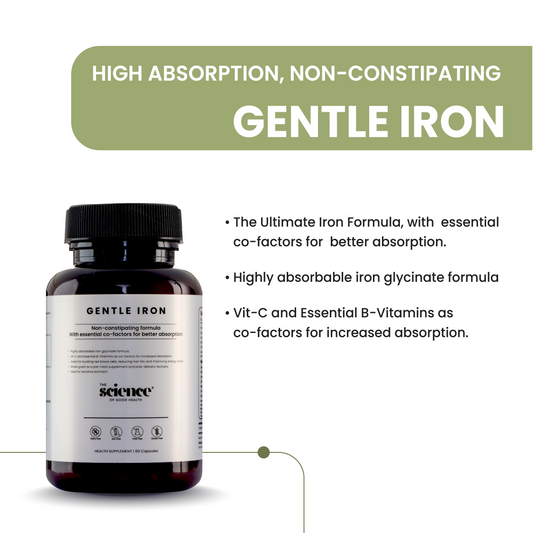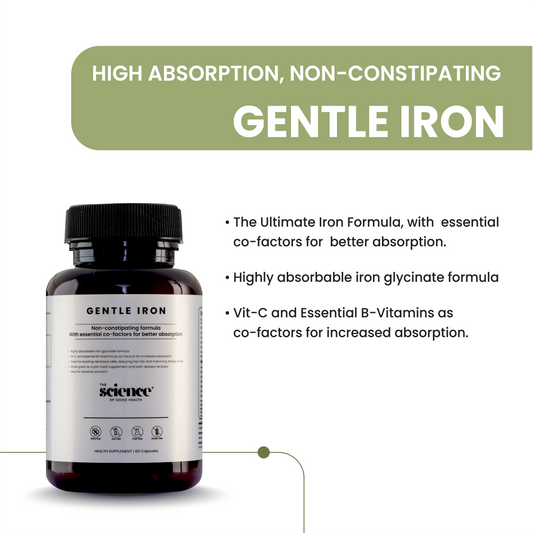If you are feeling constantly tired, weak, or low in energy, understanding how to take iron supplements correctly can make a major difference to your health. Iron is an essential mineral that helps your body create hemoglobin, a protein that transports oxygen from your lungs to every cell. When your body lacks iron, oxygen delivery decreases, causing fatigue, poor concentration, and low immunity.
Knowing how to take iron supplements the right way ensures your body can absorb this vital nutrient efficiently. This comprehensive guide explains exactly how to take iron supplements for maximum benefit, when to take them, what foods to combine or avoid, and how to choose the most effective and gentle formulation. By following these evidence-based practices, you can improve your energy levels, prevent iron deficiency, and support overall vitality.
Why Iron Matters for Your Health
Iron plays a critical role in producing healthy red blood cells and maintaining your body’s energy balance. Without enough iron, the body cannot produce sufficient hemoglobin, which leads to iron deficiency anemia. Learning how to take iron supplements correctly can prevent this condition and restore optimal energy and focus.
Common signs of low iron levels include:
- Constant fatigue or weakness even after rest
- Shortness of breath during physical activity
- Pale or dull complexion
- Hair loss or brittle nails
- Dizziness or frequent headaches
- Low body temperature and cold hands or feet
Iron also supports brain function, hormonal balance, and a strong immune response. Therefore, understanding how to take iron supplements properly is essential not only for those diagnosed with anemia but for anyone looking to maintain good health and prevent nutrient depletion over time.
Understanding Iron Supplements
When exploring how to take iron supplements, it is important to understand that there are different types and forms of iron available. Each form has its own absorption rate and level of tolerance, so selecting the right one can influence how well it works for your body.
Types of Iron:
- Heme iron comes from animal sources such as meat, fish, and poultry. It is absorbed easily by the body.
- Non-heme iron comes from plant foods and most iron supplements. Its absorption depends on your diet and the timing of intake.
Common supplement forms include:
- Ferrous sulfate – effective but may cause constipation or stomach upset
- Ferrous gluconate – gentle and suitable for mild deficiencies
- Ferrous fumarate – higher concentration for moderate to severe deficiency
- Iron bisglycinate – often labeled as gentle iron; highly absorbable and easy on digestion
Some formulations, such as The Science of Good Health Gentle Iron, combine iron bisglycinate with Vitamin C to enhance absorption while minimizing digestive discomfort. Understanding the form you are taking is an essential part of learning how to take iron supplements effectively.
When to Take Iron Supplements
The timing of intake is one of the most important aspects of how to take iron supplements. Iron is absorbed best on an empty stomach, but it can also irritate the stomach lining in sensitive individuals. The goal is to find the right balance between comfort and absorption.
Best times to take iron:
- In the early morning, about one hour before breakfast
- Between meals, when the stomach is relatively empty
- Alongside a source of Vitamin C, such as orange juice or a Vitamin C supplement
Foods and substances to avoid when taking iron:
- Calcium or dairy products such as milk and cheese, as they interfere with absorption
- Tea and coffee, which contain tannins that bind with iron and block absorption
- High-fiber cereals or whole grains immediately before or after taking iron
- Antacids or supplements containing zinc or magnesium
By following these timing principles, you can greatly improve how efficiently your body absorbs iron. Understanding how to take iron supplements with respect to timing can transform the results you experience.
How to Take Iron Supplements Properly
Knowing how to take iron supplements correctly involves more than swallowing a pill. The process includes choosing the correct type, timing your dose, and pairing it with supportive nutrients.
Step-by-step guide:
- Choose a gentle or high-absorption formula suited to your tolerance level.
- Take the supplement with a full glass of water or orange juice to aid absorption.
- Avoid taking it alongside dairy products, caffeine, or calcium supplements.
- Remain consistent each day and avoid skipping doses.
- Continue for at least two to three months, as rebuilding iron stores takes time.
- Store your supplements in a cool, dry location away from sunlight.
If you experience nausea or digestive upset, take your supplement with a small snack rather than a full meal. A formulation like Gentle Iron that contains iron bisglycinate is ideal for those with sensitive stomachs. Following these steps ensures you are practicing how to take iron supplements in the most effective and safe manner.
Common Side Effects and How to Manage Them
Even when you understand how to take iron supplements, mild side effects can occur, especially during the first few weeks of use. These reactions are usually temporary and can be managed with small adjustments.
Typical side effects:
- Constipation or hard stools
- Mild nausea or stomach cramping
- Darkened stool color
How to manage them:
- Drink plenty of water throughout the day to prevent constipation.
- Increase your dietary fiber through fruits and vegetables.
- Switch to a gentler form such as iron bisglycinate if discomfort persists.
- Take your supplement after a light snack if your stomach feels irritated.
- Avoid taking iron with other medications unless your doctor approves.
Most importantly, do not discontinue your supplement without professional advice. Understanding how to take iron supplements while managing side effects can help you stay consistent and achieve steady improvements in your health.
Who Needs Iron Supplements the Most
Certain groups of people are more prone to iron deficiency and must pay special attention to how to take iron supplements correctly.
Those who often need additional iron include:
- Women of reproductive age who lose blood during menstruation
- Pregnant and breastfeeding women with increased nutrient needs
- Children and teenagers undergoing rapid growth
- Vegetarians and vegans who consume less heme iron
- Individuals recovering from surgery or blood loss
- Athletes who experience higher red blood cell turnover
These groups can particularly benefit from learning how to take iron supplements properly to maintain balanced iron levels, support energy production, and prevent long-term deficiency symptoms.
What to Eat and Avoid When Taking Iron
Diet plays a central role in how to take iron supplements efficiently. Certain foods and nutrients can either help or hinder absorption, so combining the right ones is key.
Foods that help increase absorption:
- Vitamin C-rich fruits such as oranges, strawberries, and kiwi
- Lean meats, poultry, and fish that contain heme iron
- Legumes, lentils, tofu, and leafy greens for plant-based iron sources
Foods that reduce absorption:
- Dairy products including milk, yogurt, and cheese
- Coffee, black tea, and cocoa due to tannins and caffeine
- Whole grains and high-fiber foods immediately around supplement time
Spacing your supplement away from these blocking foods ensures that your body receives the maximum possible benefit. A clear understanding of how to take iron supplements in coordination with your diet helps you achieve long-term results.

Choosing the Right Iron Supplement
Selecting the appropriate product is a key part of learning how to take iron supplements successfully. The right supplement depends on your digestive sensitivity, the degree of deficiency, and any additional nutrients you might need.
Consider the following factors:
- Choose an easily absorbed form such as iron bisglycinate or ferrous gluconate.
- Look for added nutrients like Vitamin C, folate (B9), B12, and zinc, which help your body use iron effectively.
- Prefer non-constipating and stomach-friendly options to support long-term use.
- Check the dosage and ensure it matches your doctor’s recommendation.
- Select a brand that uses clinically tested ingredients and transparent labeling.
The Science of Good Health Gentle Iron is an example of a supplement designed for high absorption and digestive comfort. It contains ferrous bisglycinate along with Vitamin C and essential B vitamins, making it an ideal choice for anyone wanting to know how to take iron supplements without the common discomfort associated with traditional iron tablets.
Read Our latest Blogs
Iron Supplements for Hair | Iron Deficiency Supplements | Iron Supplements for Hair Loss | Iron Supplements and Black Stool | Iron Supplements for Kids | Best Iron Supplement for Anemia Without Constipation | Iron Supplements for Babies | Can Iron Supplements Cause Diarrhea | Can Iron Supplements Cause Loose Stools
Frequently Asked Questions
Q1. Can I take iron and calcium together?
No, calcium interferes with iron absorption. It is best to take iron supplements at least two hours apart from calcium-rich foods or supplements. Understanding how to take iron supplements separately from calcium ensures better results.
Q2. How long does it take for iron supplements to work?
Most people begin to feel an increase in energy after four to eight weeks, but restoring iron stores completely can take up to three months or longer. Consistency is crucial when following guidance on how to take iron supplements.
Q3. What is the safest daily dosage for adults?
Typical adult dosages range between 18 and 27 mg of elemental iron per day. However, the exact amount should be based on blood test results and professional advice.
Q4. Are liquid iron supplements better than capsules?
Both can be effective. Liquids are absorbed quickly, while capsules are easier for those who dislike the taste or want fewer stomach issues. The key lies in knowing how to take iron supplements at the right time and with supportive nutrients.
Q5. Can I take iron every day for a long time?
Yes, but only under supervision. Long-term use should be monitored with regular blood tests to prevent excessive iron buildup.
Q6. Why does my stool appear darker after taking iron?
A dark stool color is a normal side effect of iron supplementation. It indicates that unabsorbed iron is being excreted and is not a cause for concern.
Q7. Should I take iron before or after exercising?
Take your supplement either early in the morning or after exercise, never immediately before physical activity, to avoid stomach discomfort.
Q8. Can men take iron supplements safely?
Men can take iron supplements if they are deficient, but they generally require lower doses than women. A blood test should always confirm the need before starting. Knowing how to take iron supplements appropriately prevents over-supplementation.





